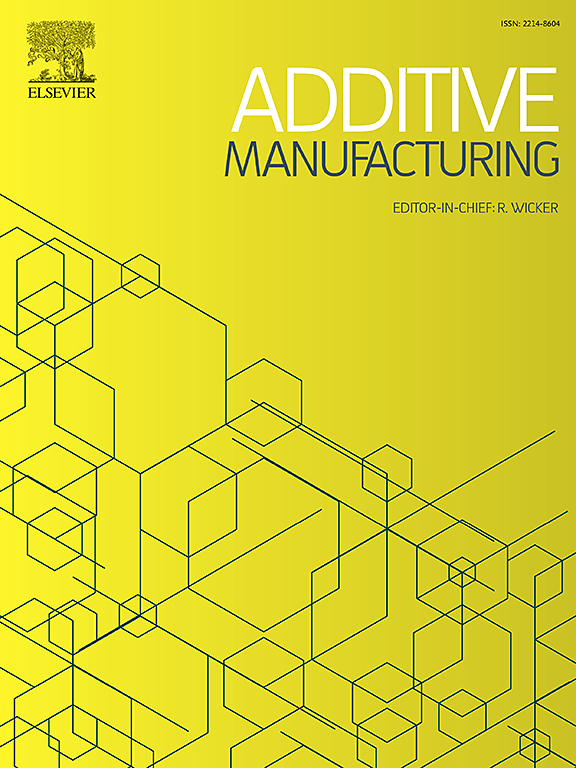增材制造中相对湿度对粉末流动性和粉末床形成的影响
IF 11.1
1区 工程技术
Q1 ENGINEERING, MANUFACTURING
引用次数: 0
摘要
粉末流动性对于粉末基增材制造工艺(如粉末床熔合、粘合剂喷射或定向能沉积)至关重要。粉末流动是粉末均匀分布和输送的前提,它决定性地影响着产品的最终材料性能和力学性能。尽管增材制造(AM)领域取得了相当大的进步,但确定可靠的方法来表征与增材制造机器中粉末扩散条件相关的粉末流动行为仍然是一个持续的挑战。在本研究中,采用标准和先进的流动性测量方法,研究了五种常规AM粉末(H282、IN738、WC17、H13和TiAl)在不同储存条件下的流动性。利用自建的散粉机和过程监测系统对粉末床进行评价,将流动性结果与粉末铺展性能进行了相关性分析。鉴于水分是流动性恶化的一个重要因素,并且在储存过程中永久控制湿度只能在相当大的费用和努力下实现,并且并非对所有实验室都可行,本研究还研究了潮湿储存条件对流动性测量和粉末分布的影响。本研究的结果表明,粉末表现出不同的性能结果时,受到选择的流动性测试方法。总的来说,在大多数评估的测量中,与IN738和TiAl相比,H282、WC17和H13粉末表现出明显更好的流动性。然而,在干燥状态下,粉末的分布可以产生具有高堆积密度的均匀粉末层,而提高水分储存条件的影响可能是相当大的,并且可能导致团聚,这可能明显破坏分布过程。对于TiAl粉末,由于其比密度低,水分对粉末流动有显著的影响。本文章由计算机程序翻译,如有差异,请以英文原文为准。
Effect of relative humidity on powder flowability and powder bed formation in additive manufacturing
Powder flowability is essential for powder-based additive manufacturing processes such as powder bed fusion, binder jetting, or directed energy deposition. Powder flow is the prerequisite for uniform powder distribution and delivery, which decisively influences the product's final material behavior and mechanical properties. Despite considerable advances in the field of additive manufacturing (AM), the identification of reliable methods for characterizing powder flow behavior that correlates with the powder spreading conditions in an AM machine remains an ongoing challenge. In this study, five conventional AM powders (H282, IN738, WC17, H13 and TiAl) were examined using standard and advanced flowability measurements under various storage conditions. The flowability results were correlated with powder spreadability using a self-built powder distribution machine and a process monitoring system for evaluating the powder bed. Given that moisture is a significant factor in the deterioration of flowability and that permanent control of humidity during storage can only be achieved at considerable expense and effort and is not feasible for all laboratories, this study also investigates the influence of humid storage conditions on flowability measurements and powder distribution. The findings of this study demonstrate that the powders exhibit disparate performance outcomes when subjected to the selected flowability testing methodologies. In general, the H282, WC17 and H13 powders demonstrate noticeably better flowability compared to the IN738 and TiAl in the majority of the evaluated measurements. Nevertheless, the distribution of powder in a manner that produces homogeneous powder layers with high packing density is achievable with all powders in the dry state, while the impact of elevated moisture storage conditions can be considerable and might result in agglomeration, which can markedly disrupt the distribution process. For the TiAl powder, with its specific low density, a significant influence of moisture on the powder flow can be reported.
求助全文
通过发布文献求助,成功后即可免费获取论文全文。
去求助
来源期刊

Additive manufacturing
Materials Science-General Materials Science
CiteScore
19.80
自引率
12.70%
发文量
648
审稿时长
35 days
期刊介绍:
Additive Manufacturing stands as a peer-reviewed journal dedicated to delivering high-quality research papers and reviews in the field of additive manufacturing, serving both academia and industry leaders. The journal's objective is to recognize the innovative essence of additive manufacturing and its diverse applications, providing a comprehensive overview of current developments and future prospects.
The transformative potential of additive manufacturing technologies in product design and manufacturing is poised to disrupt traditional approaches. In response to this paradigm shift, a distinctive and comprehensive publication outlet was essential. Additive Manufacturing fulfills this need, offering a platform for engineers, materials scientists, and practitioners across academia and various industries to document and share innovations in these evolving technologies.
 求助内容:
求助内容: 应助结果提醒方式:
应助结果提醒方式:


